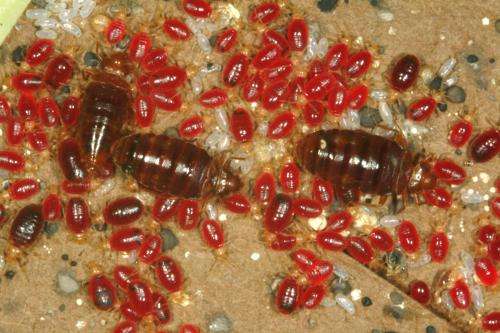(Phys.org) —Researchers from the University of Kentucky have identified 14 molecular markers in bedbug genes commonly associated with resistance to pyrethroid, the most popular pesticide used to control them. In their paper published in the journal Scientific Reports, the team describes how they compared genes from pyrethroid resistant bedbugs found in the Los Angeles area, to those from other areas of the country that had not yet developed a resistance, and as a result were able to identify 14 gene markers, that are associated with resistance to the pesticide.
Bedbugs have been in the news of late as outbreaks have occurred in cities throughout the world. They are parasites that feed on the blood of their hosts and leave behind itchy rashes. Efforts to eradicate them have become less effective as the pesticide most commonly used to kill them—pyrethroid—has become less lethal in some areas as the bugs develop resistance to it. In this new effort, the research team compared the genes of bedbugs found in the Los Angeles area that were known to have developed a resistance, with bedbug gene samples from 20 populations from other parts of the country that thus far, have not. In so doing, they found 14 markers, which they report, mostly involve the bugs' outer shell, which serves as a barrier, preventing the toxin from reaching the inner body, allowing it to survive.
The markers found by the researchers represent genes responsible for a variety of outer shell properties such as shell thickness, enzyme levels involved in metabolizing pyrethroid, etc. They also found that the markers represented two categories of defense, those responsible for neutralizing the pesticide before it could reach sensitive areas, and those that physically prevented the chemical from gaining entry to the body in the first place. Taken together, the markers represent a formidable line of defense that has evolved with bedbugs that helps them survive in a hostile environment.
Because bedbugs are evolving in ways that make them resistant to current pesticides, researchers are looking for other ways to kill them—learning more about the ways they are evolving that help them survive doses of pyrethroid gives researchers a better picture of what is occurring, which will hopefully result in revealing an unknown vulnerability that could be exploited for use in a new kind of pesticide.
More information: Bed bugs evolved unique adaptive strategy to resist pyrethroid insecticides, Scientific Reports 3, 1456, doi:10.1038/srep01456
Abstract
Recent advances in genomic and post-genomic technologies have facilitated a genome-wide analysis of the insecticide resistance-associated genes in insects. Through bed bug, Cimex lectularius transcriptome analysis, we identified 14 molecular markers associated with pyrethroid resistance. Our studies revealed that most of the resistance-associated genes functioning in diverse mechanisms are expressed in the epidermal layer of the integument, which could prevent or slow down the toxin from reaching the target sites on nerve cells, where an additional layer of resistance (kdr) is possible. This strategy evolved in bed bugs is based on their unique morphological, physiological and behavioral characteristics and has not been reported in any other insect species. RNA interference-aided knockdown of resistance associated genes showed the relative contribution of each mechanism towards overall resistance development. Understanding the complexity of adaptive strategies employed by bed bugs will help in designing the most effective and sustainable bed bug control methods.
Journal information: Scientific Reports
© 2013 Phys.org



















